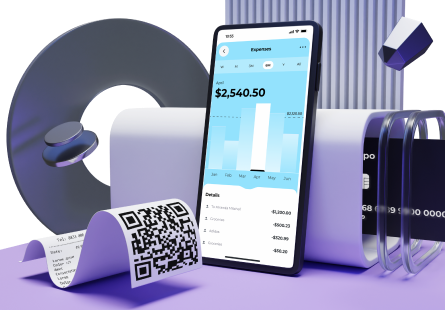The fintech industry has seen exponential growth in recent years, disrupting traditional financial services by offering innovative digital banking solutions and beyond. The fintech industry spans a wide range of services, including payments, lending, insurance, wealth management, cryptocurrency, blockchain, and insurtech, among others.
While fintech development is undoubtedly a lucrative business opportunity, it comes with some challenges. Read on to explore the top challenges of fintech and possible ways to tackle them.
Top challenges in fintech + how to overcome them
From data security and regulatory compliance to scalability issues and talent shortages, fintech development challenges can significantly slow down the growth and success of a fintech business. Here’s the list of the major problems in fintech, followed by expert tips on handling them.
Data security
Financial services providers, whether conventional banks or fintech startups, deal with massive amounts of their customers’ sensitive financial data. Data breaches can lead to dramatic reputational and financial losses, making data security one of the key challenges of the financial services industry.
According to a recent IBM report, the global average data breach cost in 2023 reached $4.45 million, 15% more than in 2020.
And while traditional banks keep money and customer data safe and secure with the help of bulletproof doors and vaults, with financial technology, everything happens over the internet, translating to higher vulnerability of assets.
Solution
To constructively respond to this challenge, fintech developers focus on ensuring that the software is secure and effectively protected from cyberattacks. This can be achieved through implementing a combination of robust security measures, including:
- Encryption. Strong encryption protocols help protect sensitive user data against unauthorised access. Encryption works by applying algorithms and mathematical functions to scramble the original data into an unintelligible form, meaning that even if a breach happens, the data will be of no use to hackers.
- Multi-factor authentication. Fintech applications with multi-factor authentication require users to provide multiple verification forms to access their accounts, adding an extra protection layer beyond traditional usernames and passwords. Multi-factor authentication typically involves a combination of a password or PIN and a biometric authentication method, such as an iris scan, facial recognition, or a fingerprint scan.
- Real-time notifications. Instant notifications allow users to promptly respond to suspicious activities.
- Penetration and vulnerability testing. These proactive security measures enable fintech companies to identify and mitigate potential security shortcomings in their applications. Penetration testing simulates real-world cyberattacks to identify weaknesses that could be exploited to get unauthorised access, while vulnerability assessments focus on identifying weaknesses by scanning the target environment for known security vulnerabilities.
Regulatory compliance
The financial industry is one of the most tightly regulated sectors as it deals with vast amounts of sensitive personal and financial data. Similar to conventional banks and other financial organisations, fintech app development is controlled by strict regulations and compliance standards, such as the GDPR, GLBA, the Money Laundering Control Act, and others. This way, regulatory bodies protect consumers from fraudulent activities and prevent money laundering and other financial crimes.
Fintech software developers must ensure that their apps comply with data privacy laws and financial regulations to avoid legal and financial consequences. However, meeting compliance requirements is even more demanding than it sounds. The fintech regulatory landscape is constantly evolving, making it challenging for financial technology companies to stay up to date.
Solution
Overcoming regulatory challenges in fintech development requires a thorough understanding of regulatory requirements and adopting appropriate compliance measures. Here are some steps to tackle this challenge:
- Regulatory research. A comprehensive research allows fintech companies to understand the regulatory landscape governing fintech operations in their target markets. A good starting point is to identify relevant laws, regulations, guidelines, and standards before building the product.
- Compliance-first design. It’s wise to integrate regulatory compliance considerations into the design and development process of a fintech product from the outset. This helps avoid compliance risks associated with product features, data handling practices, and business operations.
- Continuous monitoring of the regulatory landscape. To ensure compliance, it’s essential to stay up to date with changes in regulations. For this, many companies hire legal experts to carry out compliance oversight, monitoring, and reporting.
Scalability and flexibility
Like across many other industries, scalability and flexibility are among the common challenges in fintech.
It’s crucial for financial software solutions to be scalable, i.e., able to accommodate a growing number of users and transactions without sacrificing user experience and performance.
In addition, modern fintech solutions are usually integrated with multiple third-party services, such as banks and payment gateways, which may have diverse APIs and data formats. Fintech companies must also regularly add innovative features to their products to meet ever-evolving customer needs and stay competitive.
Solution
To effectively deal with these fintech challenges, it’s important that app developers consider scalability and flexibility when designing the product:
- Scalable infrastructure and architecture. Cloud computing services and containerization allow developers to scale up or down based on demand. Distributed systems and microservices architecture enable them to modularize components and scale independently.
- Agile approach. Agile development practices let development teams release new features and enhancements based on user and stakeholder feedback, allowing them to better meet customer needs.
- Flexible integration architecture. Flexible integration architecture supports various integration patterns, including APIs, and helps streamline integration processes and manage complexity.
User experience and personalisation
While it’s critical that a fintech app is compliant and secure, seamless user experience plays a vital role in the product’s success. User-friendly experiences directly translate to higher user retention and loyalty and, consequently, higher revenue.
Personalisation is a crucial component of the user experience in fintech apps. It involves tailoring the app’s features, content, and interactions to meet individual users’ specific needs, preferences, and behaviours.
The challenge consists in striking the right balance between performance, security and compliance on one side and a rewarding customer experience on the other.
Solution
Achieving the optimal balance requires a holistic approach. Here’s what helps fintech companies to effectively address this challenge:
- Comprehensive user research. In-depth user research allows fintech businesses to understand the target audience’s needs. Surveys, interviews, and usability testing help determine areas for improvement in the user experience.
- Personalisation algorithms. Advanced personalisation algorithms use machine learning to deliver tailored recommendations, content, and features.
- Education and customer service. Another way to boost user experience is by providing educational resources, tutorials, and customer support channels to empower consumers to use the app more confidently.
Lack of relevant tech expertise
Last but not least, lack of relevant tech expertise is among the top fintech industry challenges today. Fintech app development calls for a deep understanding of financial concepts and regulatory requirements. In addition, it requires specific technical skills, such as working with complex technologies and frameworks, and experience with agile development practices.
If a development team lacks expertise in these areas, it may struggle to build a product that meets the unique needs of the fintech sector.
Solution
There are two major ways to deal with the lack of expertise in fintech development:
- Training. Some fintech businesses invest in training programs, workshops, and certifications to upskill internal development teams in fintech-relevant technologies and methodologies.
- Hiring an external team. Another option involves partnering with an external software development company specialising in financial technology solutions. This option provides access to skilled professionals with extensive experience in fintech development, regulatory compliance, and industry best practices.

DeepInspire’s experience in solving fintech challenges
Challenge 1:
Enhance scalability and flexibility for a commodity trading platform
The client came to DeepInspire with an MVP that was unstable and couldn’t meet business needs as the number of users grew. Profitability depended on adding more clients without system issues.
The client needed a partner with deep expertise in trading platform development to optimise the product and make it highly productive, scalable, and easily updatable. The goal was to create a world-class commodity trading platform for producers, traders and buyers to connect and transact.
Solution:
The challenge was to review and improve both the front-end and back-end components of the system. We thoroughly examined the code and did an extensive scope of work . As a result, the client’s MVP was completely rewritten, making the codebase simple and easy to maintain.
Since the client aims to launch the product globally, we transformed the commodity trading platform into a flexible solution that can be adapted to different markets. We upgraded the engine to allow configuration instead of hard-coding industry-specific information, making the platform easily adjustable to any industry and type of commodity.
Ultimately, we helped the client turn their product into a high-performance commodity trading platform with an easy-to-maintain codebase and scalable architecture, adaptable to other markets.
Challenge 2:
Improve user experience for an institutional-grade trading platform
A fast-growing company needed to support a growing number of new customers and wanted to optimise the KYB user onboarding process. The main pain point was the confusion during the initial KYB information submission, which led to excessive time consumption for both users and compliance officers.
The main challenge was to improve the user experience for new users and save time for both users and compliance officers without making major changes to the framework and form composition. We aimed to streamline communication with users and within the department.
Solution:
We interviewed stakeholders, performed user research, and defined the key pain points to solve. Our team then developed a new, streamlined solution for the KYB flow. A UX expert designed the information architecture and created wireframes for all KYB sections. After validating the concept with stakeholders and achieving positive results in user testing, we proceeded to design a consistent UI for over 40 screens based on these wireframes.
The custom KYB solution we built:
- Is optimised, simplified and smooth;
- Doesn’t cause any difficulties or frustration;
- Saves time for both users and compliance officers;
- Helps to concentrate the user’s attention and significantly eliminate mistakes;
- Builds user loyalty and trust in the product during first visits;
- Keeps users engaged while gathering KYB information;
- Facilitates the everyday work of compliance officers.
Challenge 3:
Rebuild and modernise a precious metal trading platform and improve customer experience
The client, the largest gold refiner in the UK, approached DeepInspire with an existing platform for precious metal trading. The platform was developed quite some time ago and is currently outdated and non-functional, necessitating a complete rebuild.
Solution:
Our goal within this project was to deliver a comprehensive enterprise-grade digital transformation across different aspects of the company’s operations.
We decided to create a business tool that enables multiple entities to accept various payment types through a single, user-friendly interface. The goal is to make managing orders, customers, and compliance easier and more streamlined. Essentially, the system must effectively guide and facilitate both online and offline aspects of the business.
Our collaboration resulted in more than just an upgraded trading platform – it represents a comprehensive digital transformation aligned with today’s market expectations:
- Improved sales and purchasing processes for clients and the sales team;
- Automated processes, enhanced platform efficiency, and increased revenue;
- Unified order, customer, and compliance management with a versatile payment interface;
- Simplified precious metal purchases with an intuitive interface;
- Empowered the sales team with a centralised Backoffice application for streamlined operations.
Final thoughts
Fintech software development is a highly promising business opportunity despite some tough challenges. The good news is that there’s a solution for each.
Still, fintech development is more complex than other domains, mainly due to the demanding regulatory landscape, the need for specialised tech expertise, and data security concerns, which is why it’s wise to entrust your project to fintech experts.
DeepInspire offers a team of fintech-savvy developers with 20+ years of experience in banking software development, including open banking integrations.
We have the necessary tech stack and regulatory expertise to build high-performing, scalable, secure, and user-friendly fintech products to meet the needs of your target audience. Book a call to discuss how we can help you deal with the challenges in fintech and develop a successful application.







